
2015-08 Special 2015
.pdf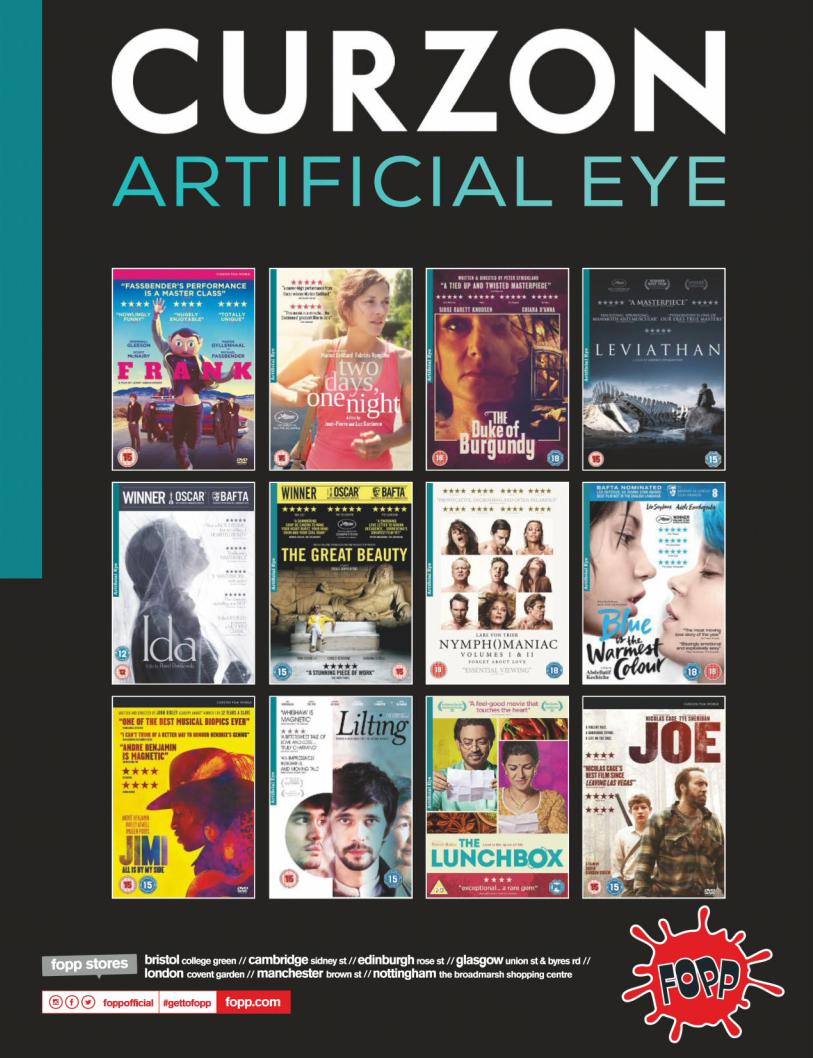
U
! "$ # |
$ ! % & " |
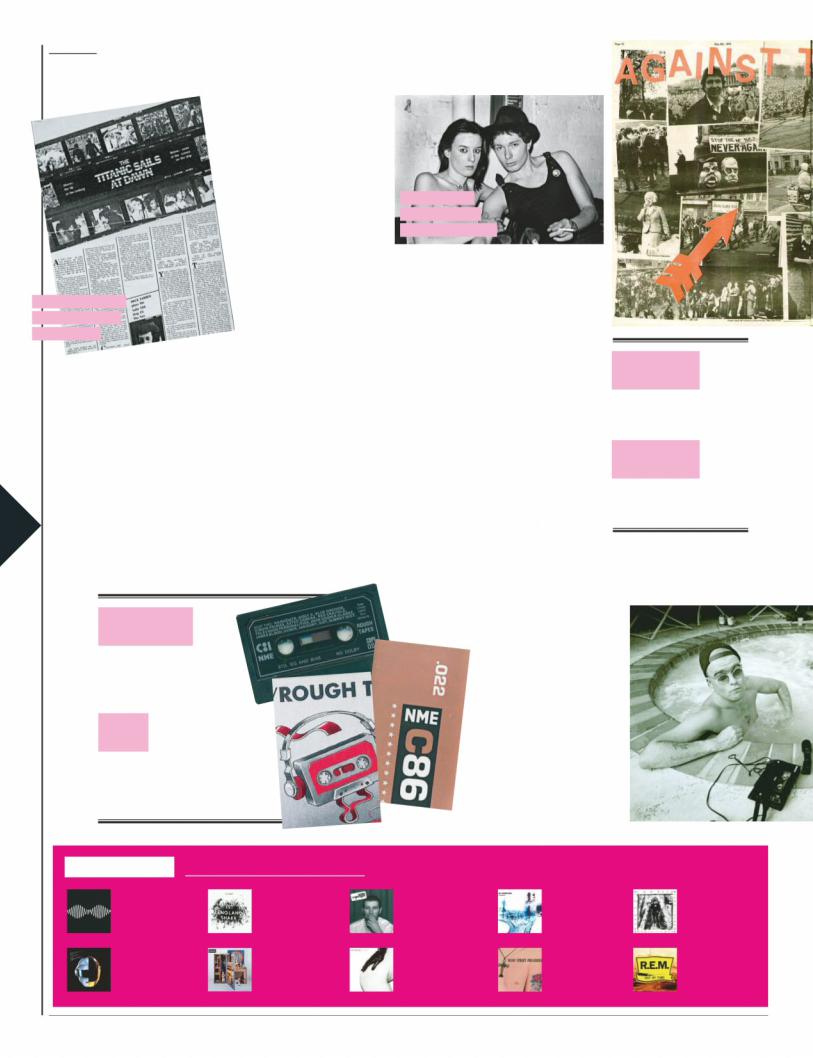
12
Poached from the underground press, Kent and Murray brought instant depth and credibility to the new-look NME: they were young, passionate and impossibly hip, and wrote
about rock music with the eloquent conviction and high-mindedness it deserved. They also
looked and lived like the artists they wrote about: it was a time of excess, of record company expense
accounts, of flying around the world at the drop of a hat to go and hang out with Bowie, Jagger or
Led Zeppelin, and in true New Journalism style, the writers themselves often became the story. Kent’s exploits, in particular, would become the stu of legend: he would join an early incarnation of the Sex Pistols, got whipped with a motorcycle chain by Sid Vicious, and embarked on a doomed, smack-addled bromance with Keith Richards that almost killed him. These were heady times to be an NME journalist, but they were hazardous ones, too.
Under the influence of sta ers like Charles Shaar Murray and Ian MacDonald, the NME o ce became a place where editorial meetings were held in clouds of dope smoke and copy was written on teeth-grinding amounts of amphetamines. It became a subversive countercultural bible, rock music’s uno cial paper of record, but the arrival of punk – heralded by Mick Farren’s seminal 1976 essay ‘The Titanic Sails
£2.95
Cost of NME’s scenedefining 1986 mail order cassette, ‘C86’
38
Number of cassette compilations NME produced in the ’80s
NME journalists
Julie Burchill and
Tony Parsons in 1978
At Dawn’ – would propel NME to even greater heights.
While the paper had given the Sex Pistols their first piece of press coverage (and was later namechecked in the lyrics of ‘Anarchy In The UK’), NME was slow to embrace punk, but the arrival of Tony Parsons and Julie Burchill would soon change that. After answering an ad in the paper looking for “hip young gunslingers”, Parsons and Burchill would ultimately come to represent another changing of the guard: younger and better-connected to the punk scene than their predecessors, their writing gave NME an eloquence, influence and circulation which far outstripped its rivals.
Punk politicised everything it touched, and by the late ’70s and early ’80s,
NME had developed a strong social
conscience, editorialising against Margaret Thatcher and the National Front, championing the Rock Against Racism campaign and later throwing its support behind Red Wedge, a left-wing collective of artists committed to ousting Thatcher at 1987
General Election. But music – specifically new music – remained NME’s mission,
and to some extent, the paper and emergent independent scene of the 1980s would come to define each other. NME faithfully reported on the goings-on at labels like Rough Trade, Postcard and
Factory, but with its ‘C81’ and ‘C86’ cassette compilations, we also helped to define and contextualise these scenes for readers who lived far from where they were happening.
TOP MARKS |
10 albums that got 10/10 in NME |
|
|
|
|
►AM |
►Let England |
►Whatever People |
►OK Computer |
►Magic |
|
Say I Am, That’s |
|||||
Arctic Monkeys |
Shake |
Radiohead |
And Loss |
||
What I’m Not Arctic |
|||||
(2013) |
PJ Harvey (2011) |
(1997) |
Lou Reed (1992) |
||
Monkeys (2006) |
|||||
|
|
|
|
||
►Random Access |
|
►Generation |
►Out Of Time |
||
►Is This It |
Terrorists Manic |
||||
Memories |
►Stop The Clocks |
REM (1991) |
|||
Street Preachers |
|||||
Oasis (2006) |
The Strokes (2001) |
||||
Daft Punk (2013) |
|
||||
(1992) |
|
||||
|
|
|
|||
|
|
|
|
||
NEW MUSICAL EXPRESS | 1 AUGUST 2015
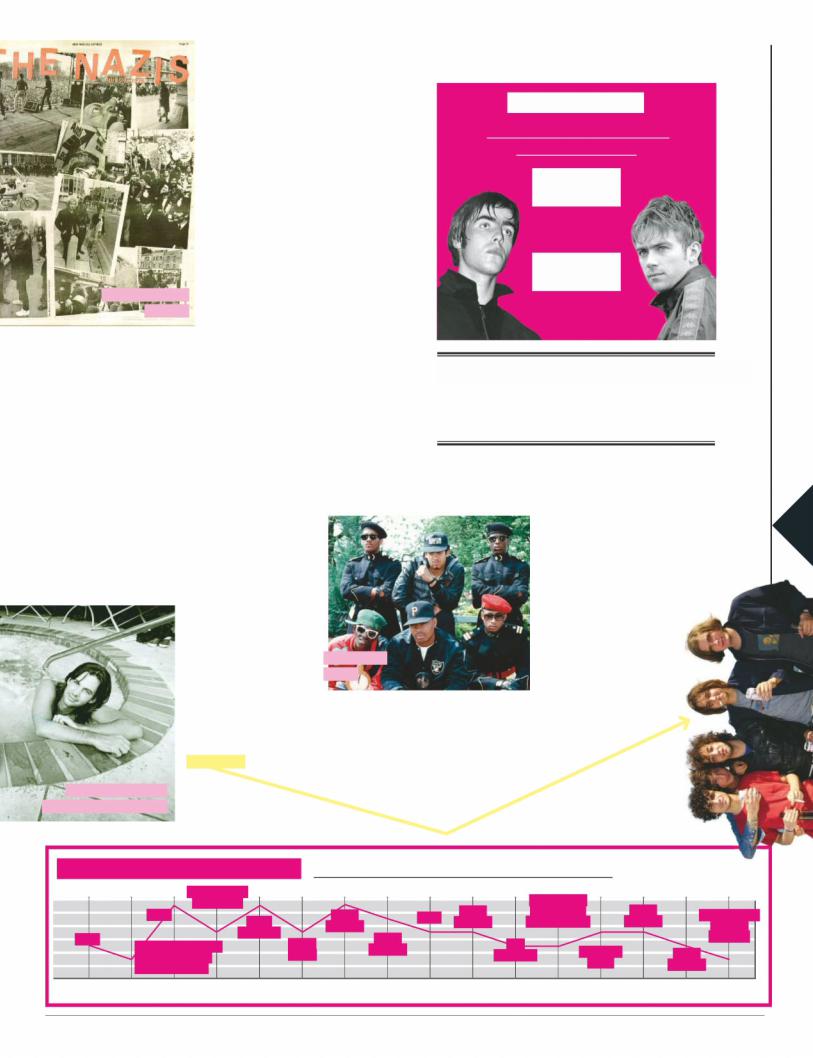
Meanwhile, indie acts like The Smiths – whose frontman, Morrissey, had once been a fixture of the letters page (see pages 4-5)
–became the paper’s new deities. Conflict loomed, however, in the form
of the so-called ‘hip-hop wars’, when the o ce became factionalised between adherents of the predominately white, traditionalist rock music many of the writers regarded as the paper’s purview, and the impossibly exciting sounds
coming from the streets of black America. The hip-hop warriors eventually won, and 25 years before Kanye West upset the rock aristocracy by announcing himself “the greatest living rock star on the planet,” the October 8, 1988 cover of
NME declared Public Enemy “the greatest rock’n’roll band in the world”.
Indie remained the paper’s bread and butter, however, and a series of questionable late-’80s cover stars (Cilla Black, anyone?) hinted at a scene in the doldrums. Things were briefly enlivened by the advent of baggy and acid house, as well as the inimitable, apoplectic scribblings of Steven ‘Swells’ Wells, but it wasn’t until the arrival of Britpop that the magazine began to flourish again. The great Blur vs Oasis
battle began at the NME Brat Awards (a modern-day successor to the old Poll Winners’ Party) in January 1995, and the flames were stoked
further by the mischief-making cover of August 12, 1995, in which Liam Gallagher and Damon Albarn were depicted as rival boxers ahead of the looming chart battle between ‘Roll With It’ and
‘Country House’. Such was the appetite for all things Oasis, a recording of the Gallagher brothers’ riotous 1994 interview with NME’s John Harris, titled ‘Wibbling Rivalry’ and released on Fierce
Panda, even managed to sneak into the UK singles chart.
In the modern era, NME was the first major publication to champion bands like The Strokes, The White Stripes, Arctic Monkeys and countless others who would go on to set the musical agenda for the next decade. Throughout its existence, the paper
has weathered huge musical and technological
OASIS VS BLUR
The result of the NME-endorsed 1995 battle of Britpop
216K
OASIS
Roll With It
274K
BLUR
Country House
THE BATTLE BEGAN AT THE NME BRAT AWARDS, A SUCCESSOR TO THE POLL WINNERS’ PARTY
sea changes in the industry it covers, bearing witness to the births of rock’n’roll, Beatlemania, punk rock, hip-hop, the internet and the MP3, and in 1996
launched its online arm, NME.COM, presaging the publishing industry’s move from print to digital. Change has been its only real constant, which is why every generation looks back on its own NME di erently, and invariably through rose-tinted shades. It was always better back in whichever day
you read it, because no publication survives this long by staying the same: the paper has always had to adapt to the times, and
move with them when necessary. Across every epoch of rock’n’roll, through the ups and downs, the lulls and booms, NME has always been at the forefront of new music, a source not only
of news and reviews, but of debate, dissent, and above all, passion. We approach the future cognisant of the most valuable lesson learned from our past: that music doesn’t stand still, and we can’t a ord to, either. ▪
NME IN THE 21ST CENTURY The artists who have dominated the cover since 2000
|
|
|
Radiohead and |
|
|
|
|
|
|
|
|
|
|
|
|
|
6 |
|
|
The Strokes |
|
|
|
|
|
|
|
The Vaccines, |
|
|
|
|
|
|
|
|
|
|
|
|
|
|
|
|
|
|
|
|
||
|
|
|
|
|
|
|
|
Arctic |
|
Kasabian and |
|
Arctic |
|
|
||
|
|
Oasis |
|
|
|
Arctic |
|
Muse |
|
|
|
The Libertines |
||||
5 |
|
|
Franz |
|
|
Monkeys |
|
Arctic Monkeys |
|
Monkeys |
|
|||||
|
|
|
|
|
|
|
|
|
|
|||||||
|
|
|
|
Monkeys |
|
|
|
|
|
and Noel |
||||||
4 |
|
|
Ferdinand |
|
|
|
|
|
|
|
|
|
|
|||
|
|
|
|
Arctic |
|
|
|
|
|
|
|
|
Gallagher |
|||
Oasis |
|
|
|
|
|
|
|
|
|
|
|
|
|
|
||
|
|
|
|
Kaiser |
|
|
|
The |
|
|
|
|
|
|
||
3 |
The Strokes, Gorillaz, |
|
|
Monkeys |
|
|
|
The Stone |
|
|
|
|||||
|
Chiefs |
|
|
|
Libertines |
|
Arctic |
|
||||||||
|
Courtney Love and |
|
|
|
|
|
|
|
||||||||
2 |
|
|
|
|
|
|
Roses |
|
|
|||||||
|
|
|
|
|
|
|
|
|
|
Monkeys |
||||||
The White Stripes |
|
|
|
|
|
|
|
|
|
|
||||||
|
|
|
|
|
|
|
|
|
|
|
|
|||||
1 |
|
|
|
|
|
|
|
|
|
|
|
|
|
|||
|
|
|
|
|
|
|
|
|
|
|
|
|
|
|
|
|
2000 |
2001 |
2002 |
2003 |
2004 |
2005 |
2006 |
2007 |
2008 |
2009 |
2010 |
|
2011 |
2012 |
2013 |
2014 |
2015 |
13
1 AUGUST 2015 | NEW MUSICAL EXPRESS
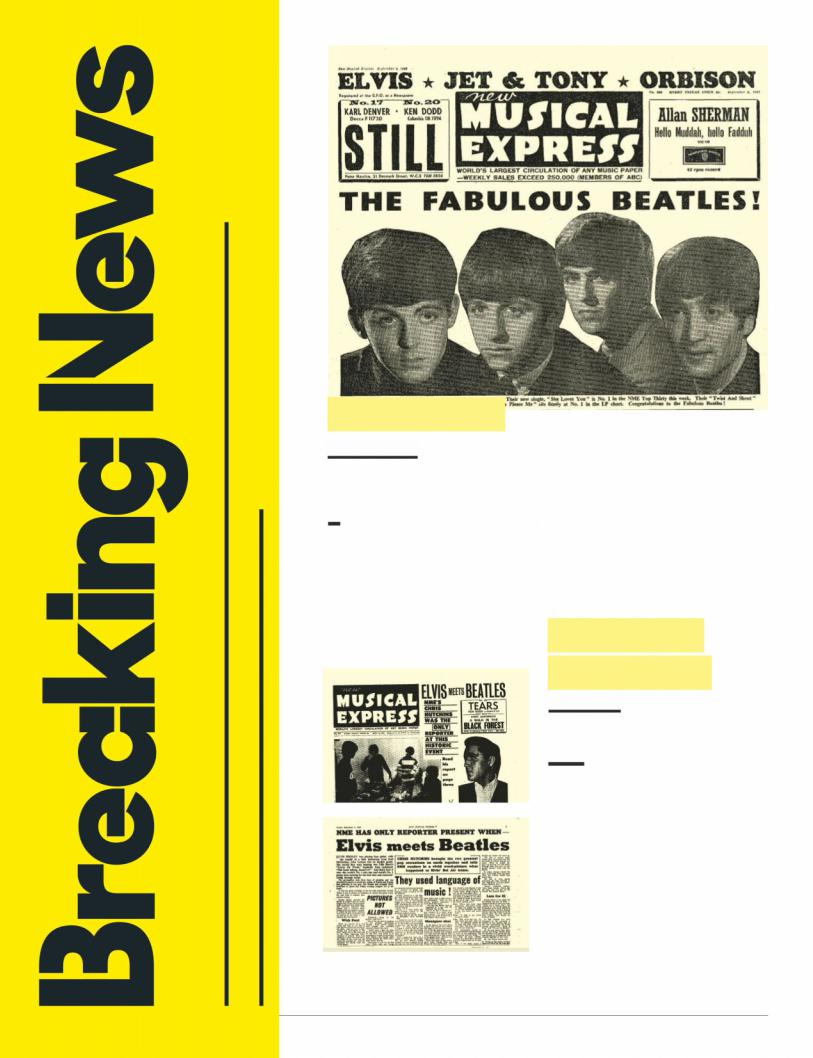
look back at the biggest news stories and strangest |
we covered them |
►Scoop! From Beatlemania to Pussy Riot, a |
happenings from NME’s history – and how |
Beatlemania
November 1963
IBeatles and their mop-topped ilk began to dominate the news pages of NME, event was a new dawn for rock’n’roll as The
if they continued to be asked the same tame questions (who’s the strongest Beatle? Ringo, because he has to carry the drums). The hysteria surrounding the band was
acknowledged by a report on the 1963 Royal Variety Show – the one where John Lennon told the toffs to “rattle your jewellery” – which marvelled at the fact that The Beatles got through their set “without a scream!”
Elvis meets
The Beatles
August 1965
Aimportant musical forces of the 20th century, Elvisrguably the two most
and The Beatles crossed
paths only once: on August 27, |
|
|
1965, at Presley’s home in Bel |
|
|
Air, California. It took three days |
|
|
of secret planning to set up, and |
|
|
NME’s Chris Hutchins was the |
|
|
only journalist allowed to attend. |
NICOLSON, |
COOPERLEONIE |
What he saw was remarkable: Elvis, |
||
John Lennon, Paul McCartney and |
|
|
George Harrison jamming together |
|
|
(“Too bad we left the drums in |
BARRYRICHARDS,SAMWORDS: |
MONROE,JAZZMACKAY,EMILY |
Memphis,” Elvis told Ringo) and |
||
casually chatting into the wee |
|
|
hours about music, cars and life on |
|
|
the road. It was a fly-on-the-wall |
|
|
experience like no other, even if |
|
|
The Beatles later admitted to being |
|
|
unimpressed by the King’s banter. |
|
|
NEW MUSICAL EXPRESS | 1 AUGUST 2015
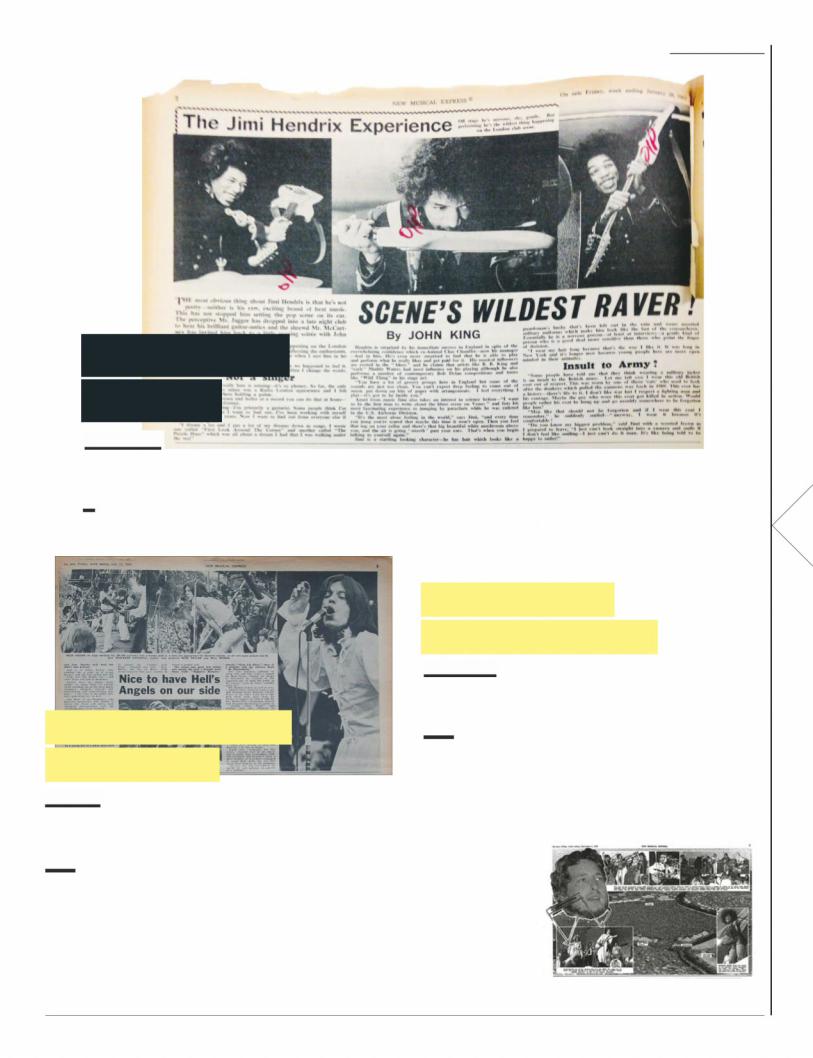
BREAKING NEWS
Hendrix hits
London
January 1967
n early ’67, NME was wowed by the |
“scene’s wildest raver”! As Jimi’s version |
arrival on our shores of a strange, |
of ‘Hey Joe’ climbed the charts, NME’s |
exotic creature called Jimi Hendrix. |
John King got to know the “nervous, |
IHe wore frilly blouses! He played |
gentle kind of person” behind the “Wild |
guitar with his teeth! He was the |
Jimi Hendrix” image, discovering that |
he loved sci-fi, hated miming, and that a lot of his songs came from dreams: “I wrote one called ‘The Purple Haze’ [sic] which was all about a dream I had that I was walking under the sea.”
15
The Rolling Stones
in Hyde Park
July 1969
Tlive show in two years was meant to be theirhe Rolling Stones’ first
chance to introduce new guitarist Mick Taylor. But when his predecessor Brian Jones drowned in the pool of his Sussex mansion two days beforehand, the purpose and tone of the free festival became very different, with Jagger reading the poem Adonais (Shelley’s elegy for Keats) and releasing hundreds of cabbage-
white butterflies – although half of them fell dead from their boxes due to lack of airholes. NME’s Nick Logan wasn’t exactly swept away with emotion: “Mick Jagger… shook his bottom, as is his wont, and I, after six hours of earthly contact with Hyde Park, made the discovery that by pressing my palms to the grass I could lever mine a glorious inch above the ground and for a brief moment alleviate the discomfort.”
Dylan’s Isle Of Wight comeback
August 1969
TWight festival, headlined by Jefferson Airplane,he inaugural 1968 Isle Of
had been a modestly attended affair. But the following year’s crowd numbered in the hundreds of thousands, all
of them there to witness one of the festival industry’s first major coups: the return of Bob Dylan. Following his 1966 motorcycle accident,
Dylan had largely retired from public life, so interest in his first live performance in three years was naturally huge, and watching intently from the crowd were members of The Beatles and the Stones. Yet what’s most striking
about Richard Green’s NME report is how little things have changed when it comes to music festivals. Even back in the summer of ’69, attendees were already grumbling about delays, short set lengths, taxi drivers charging inflated fares and – worst of all – “the people who asked seven-and-six for a hamburger and chips”.
1 AUGUST 2015 | NEW MUSICAL EXPRESS
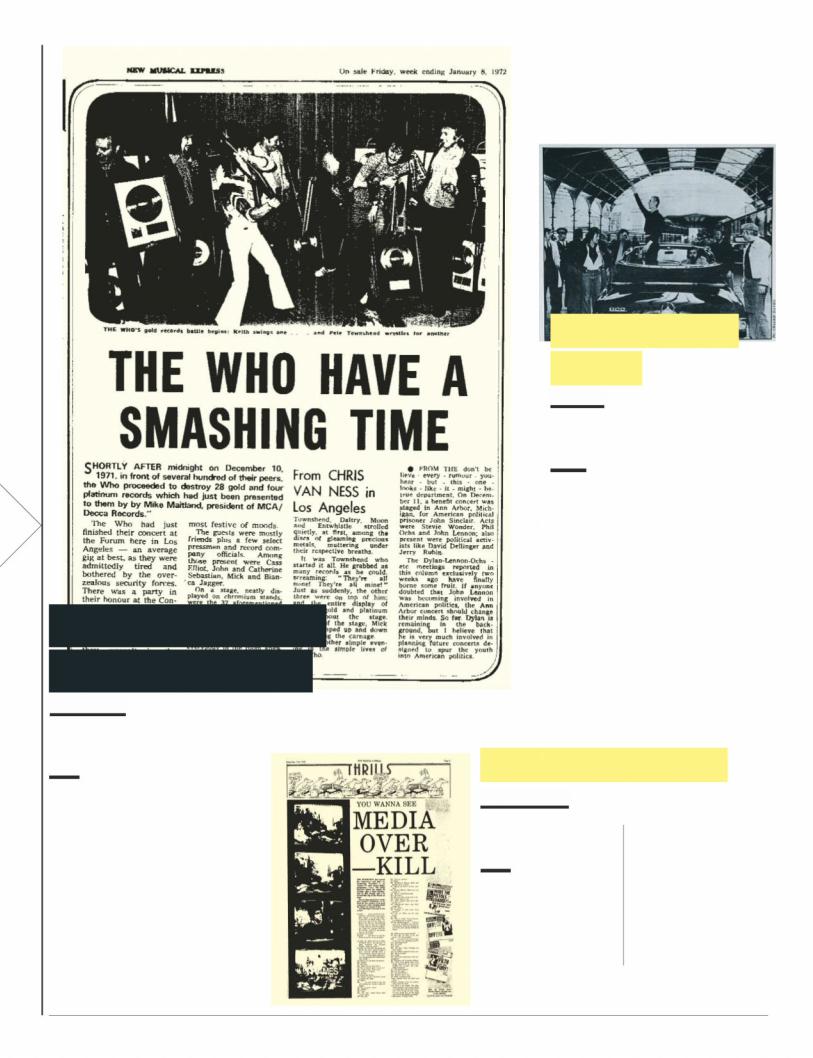
16
The Who smash their gold discs
January 1972
Trock’n’roll auto-destruction: Pete Townshend was the first rockerhe Who wrote the book on
to trash his guitar, while Keith Moon, on the band’s US TV debut, filled his bass drum with explosive charges, slightly deafening himself. So it was little surprise to find them, at an afterparty for a less-than-satisfactory gig at the LA Forum, smashing the shit out of 32 gold discs presented to them by their label. Townshend instigated the destruction, then “just as suddenly, the other three were on top of him”, reported NME’s Chris Van Ness, “and the entire display of gold, chrome and platinum flying about the stage. Mick Jagger jumped up and down, encouraging the carnage. Just another simple evening in the simple lives of The Who.”
Bowie’s ‘Nazi’ salute
May 1976
Asuggesting to reporters that Britain could benefitfew days after foolishly
from a fascist leader, David Bowie turned up at London’s Victoria station making what looked like a Nazi salute from the back of his Mercedes convertible. NME’s report was more concerned with Bowie’s failure to address the crowd than any perceived Nazi undertones. Bowie has always claimed he was simply waving to fans, blaming his brief obsession with fascism on the coke-fuelled delusions of the Thin White Duke. However, NME was not prepared to give self-indulgent rockers an easy ride for much longer. A few weeks later, in the June 19 issue, Mick Farren would pen a legendary NME editorial entitled ‘The Titanic Sails At Dawn’, calling time on ’70s rock star decadence and helping to usher in the punk revolution.
“You dirty fucker!”
December 1976
Texpecting to watch an interview with Queen,he nation was
when instead it got an unexpected gob-full of punk. “You’ve got another five seconds. Say something outrageous,” goaded Thames TV’s Today host Bill Grundy. “You dirty bastard!” offered the Sex Pistols’ Steve Jones,
before topping that with “You dirty fucker!” and “What a fucking rotter!” NME published the whole hoo-ha “unexpurgated” and reported on the banning of the Pistols’ UK tour and the ‘Anarchy
In The UK’ single. Malcolm McLaren is quoted as saying that Jones merely used language “in everyday use”.
NEW MUSICAL EXPRESS | 1 AUGUST 2015
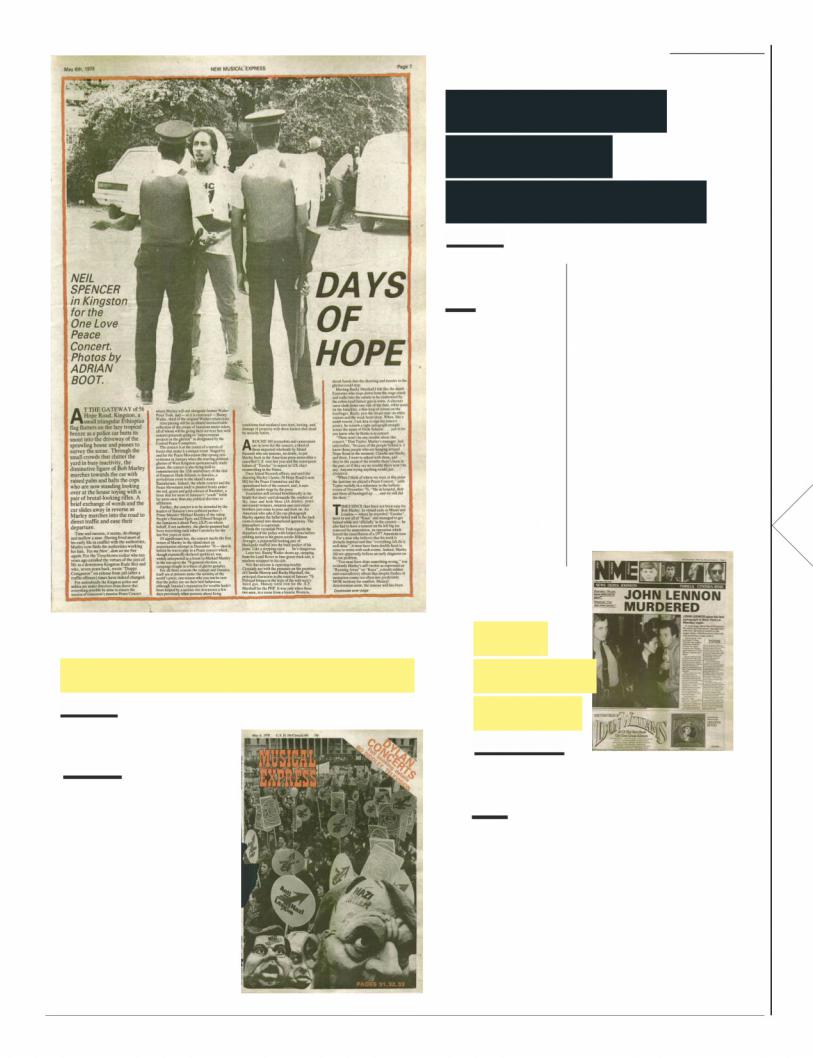
Rock Against Racism rally
April 1978
With punk having revolutionised not only the music we covered but the way
we covered it, NMEthrew its support behind the Rock Against Racism campaign, set up in 1976 to counteract the rise of far-right groups. The 1978 rally saw almost 100,000 people march from Trafalgar Square to Victoria Park for a special concert headlined by The Clash. To commemorate the event, NMEran a cover image taken from the demo itself: a sea of Anti-Nazi League and proimmigration placards, juxtaposed withthegrotesquee giesof NationalFrontleadersMartin Webster and John Tyndall.
BREAKING NEWS
Bob Marley’s
One Love
Peace Concert
April 1978
he One Love |
Once a revolutionary |
Peace Concert |
firebrand, the singer |
at Kingston’s |
seemed, this time, to |
TNational Stadium |
sympathise with the |
was crucial not just for |
politicians. Maybe he |
Bob Marley – whose |
was just sick of fighting |
return marked his first |
(unlike band member |
appearance on home soil |
Bunny Wailer, who had |
since an assassination |
a machete slung round |
attempt in 1976 – but for |
his waist), but Marley |
the whole of Jamaica. |
worked political magic. |
Warring political rivals |
The concert climaxed |
Michael Manley and |
as he brought out |
Edward Seaga had |
Manley and Seaga for |
finally declared peace, |
‘Jammin’’, linking their |
but, at a time when |
hands together in one |
police brutality was |
of the decade’s most |
stoking youth distrust of |
enduring images. |
authority, it fell to Marley |
|
to unite the people. |
17 |
NME’s Neil Spencer |
slowly came round to Marley’s myth-making.
John Lennon’s murder
December 1980
Acruelly extinguished by the hand of an angry lone nutcase: the death of John Lennon wasshining symbol of the promise of the 1960s,
rock’n’roll’s JFK moment, and no-one who was alive at the time would ever forget where they were when
they heard about it. In addition to a blow-by-blow account |
O’REGAN |
of what went down that fateful night in New York, NME’s |
|
coverage also included information about Lennon’s final |
DENNIS |
interview (given to BBC Radio 1 days before his death), a |
|
reflection on his five years away from the spotlight, and a |
BOOT, |
personal reaction piece from Charles Shaar Murray, which |
|
perfectly articulated the sense of anger and confusion felt |
ADRIAN |
by millions around the world. “Next week we can talk about |
|
Lennon’s life, his music, his contribution to the medium in |
DAVIES, |
which he worked,” wrote Murray. “Today we just deal with |
|
the sorrow and the anger, and rage at the futility and the |
CHALKIE |
injustice and the madness.” |
1 AUGUST 2015 | NEW MUSICAL EXPRESS
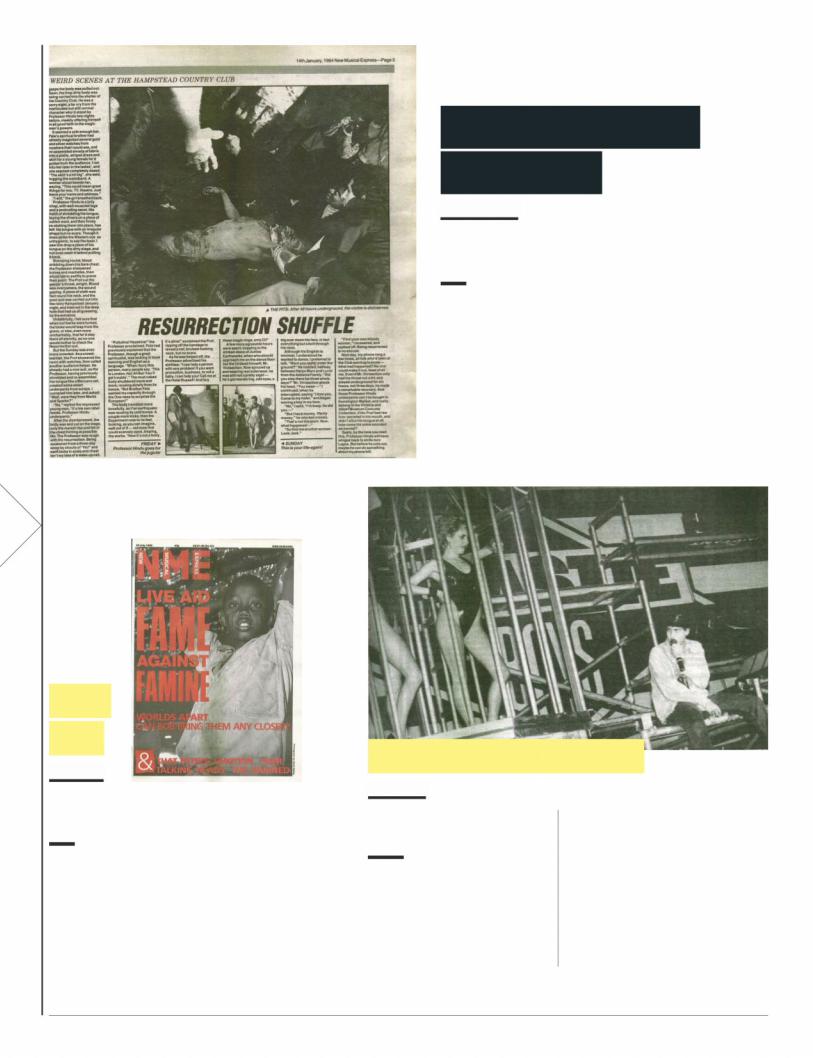
Fela Kuti raises the dead
January 1984
ollowing a Brixton Academy show by FAfrobeat legend Fela Kuti, NME’s Vivien
Goldman was lured to a small club performance by Kuti’s “spiritual advisor”
Professor Hindu with the promise of a full-on resurrection. At Hampstead’s Country Club, she duly witnessed a bizarre ritual in which a man had his throat cut with a machete before being buried outside the club. Two days later she was back to see his body hauled out of the ground before, with a shout of “Pollutina Hezekina!” and a few kicks to the chest, the Professor returned the man to the land of the living. It seems that spending 48 hours in the ground hadn’t dampened the victim’s libido: when Goldman attempted to interview him, he could only say: “I love you. Come to my hotel.”
18
Live
Aid
July 1985
Fcampaign, Bob Geldof rallied a cast of rock megastars for two televised concerts inollowing the success of 1984’s Band Aid
London and Philadelphia, raising over £50m for African famine relief. NME’s tone was sceptical, epitomised by headlines such as ‘Fame Against Famine’ and a nagging feeling that, in Don Watson’s words, this was “corporate pop turned corporative charity”. Paul Du Noyer, reporting from Wembley Stadium, acknowledged that “at worst… it means you’ve got some hypocritical bastards in the pop world walking round with dry-cleaned consciences”. Ultimately, though, he was moved by the event and noted that, for the first time since the ’60s, the rock aristocracy were “starting to look at the wider world again, through thoroughly practical eyes”.
Ad-Rock in the dock
June 1987
Acages, a 24-foot hydraulic penis and tabloid accusations ofccompanied by women in
verbally abusing disabled kids, Beastie Boys’ maiden UK tour ended in a riot when their Liverpool show was abandoned after only 10 minutes as a hail of beer cans hit the stage. Frustrated, the Beasties started batting
the cans back into the crowd, where one was alleged to have hit a 20-year-old fan in the face, landing Ad-Rock in court
on assault charges. As NME reported, it was only one of several ignominies to befall the budding rap brats on these shores: MCA had a drink thrown in his face in a London club, while they had to cancel their Glasgow show because no hotels would agree to put them
up. Was this opprobrium deserved? Not according to NME reviewer Gavin Martin, who called them “genuinely liberating… the air of threat and menace is not present in their cartoon-iverse.”
NEW MUSICAL EXPRESS | 1 AUGUST 2015
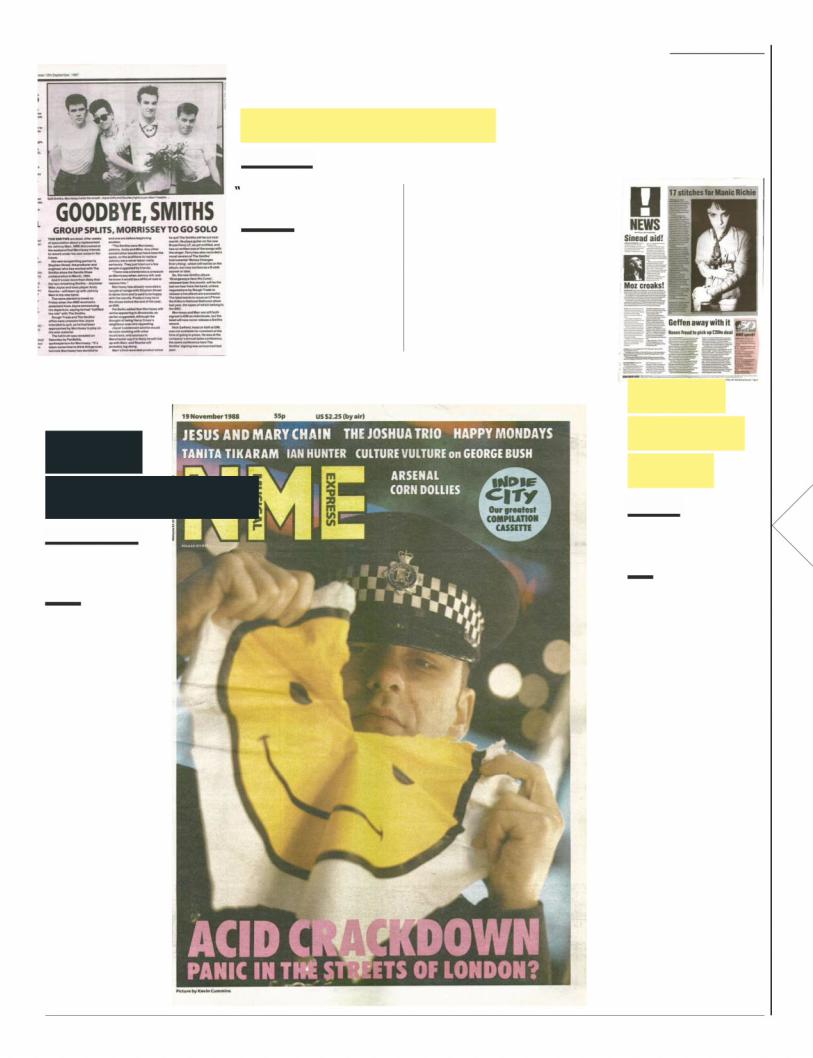
The Smiths split up
August 1987
WSmiths have split shall be severelyhoever says The
spanked by me with a wet plimsoll,” quipped Morrissey as the vultures circled, but the NME newshounds would not be denied – the following week they reported that Johnny Marr had left the band. “The thing that used to make me happy was making me miserable,” explained the guitarist. Could The Smiths
limp on? EMI’s A&R man, having only just signed the band, was optimistic. But despite the vague mention of “other guitarists”, two weeks later NME announced with finality: “The Smiths are dead.” Poignantly, the same issue carried a review of what was sadly now to be the band’s final album, ‘Strangeways, Here We Come’,
“a masterpiece that surpasses even ‘The Queen Is Dead’ in poetic, pop and emotional power”.
“Acid
crackdown”
November 1988
Awere arrested at an “acidfter 62 people
house party” in Ipswich – the latest in series of police raids in response to media-generated acid house hysteria
– NME attempted to disentangle fact from tabloid fantasy.
Naturally, it suspected the Murdoch press of attempting to orchestrate a police crackdown on a potentially subversive youth culture. “The press… has meshed drugs and acid house into a bog-eyed
dribbling bogeymen in a smiley T-shirt,” wrote Steven Wells. Some scene pioneers were already bailing as a result of the unwanted attention. “Anyone who holds a warehouse party now must be mad,” said DJ Nicky Holloway. “As for acid house, it’s finished.”
BREAKING NEWS
Richey Manic is 4 real
May 1991
ollowing their gig at |
19 |
Norwich Arts Centre, |
|
Manic Street Preachers |
|
Fsat down with NME’s |
|
Steve Lamacq to talk about |
|
credibility, conviction and |
|
“what a sham some people |
|
think they’ve become”. |
|
After the interview finished, |
|
guitarist Richey Edwards |
|
delivered a macabre coup de |
|
grâce to Lamacq’s sceptical |
|
argument by picking up |
|
a razor blade and carving |
|
‘4 REAL’ into his forearm. |
|
“As Richie’s arm turns into |
|
a wash of blood,” wrote a |
|
shocked and shaken Lamacq, |
|
“my mind wakes up to the |
|
situation and I get away to |
|
tell their manager to help him |
SIRRS |
out.” Edwards was rushed to |
|
hospital, where he received |
ED |
|
|
17 stitches. The incident |
CUMMINS, |
caused a sensation, and the |
|
frantic debate in the NME |
KEVIN |
it – recorded for a BBC radio |
|
office about how to cover |
BAILEY, |
documentary – was issued |
|
as a B-side on the Manics’ |
|
‘Theme From MASH (Suicide |
DAVID |
Is Painless)’ single, entitled |
|
‘Sleeping With the NME’. |
SLATTERY,PAUL |
1 AUGUST 2015 | NEW MUSICAL EXPRESS
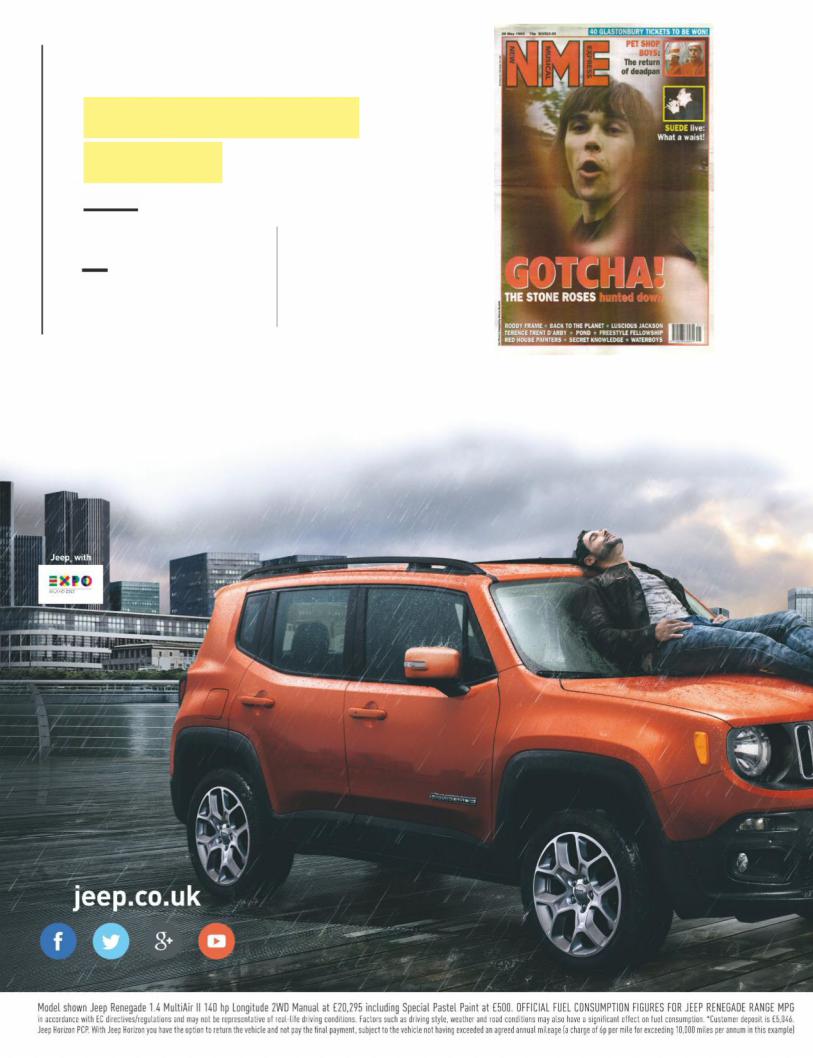
The Stone Roses:
Gotcha!
May 1993
Fepochal self-titled debut, The Stone Roses’ inability to produceour years since the release of their
a follow-up album had led many to speculate that the band were finished. And so NME turned supersleuth, tracking the Roses down to a rehearsal studio in suburban Manchester. Strangely enough,
the band weren’t particularly keen to talk to us, so we had to make do with just
a few snatched photos of Reni’s drumkit and Ian Brown walking to his car, plus the shocking revelation that the band had stopped wearing flares. Who says NME hasn’t brought you the biggest scoops down the years?
